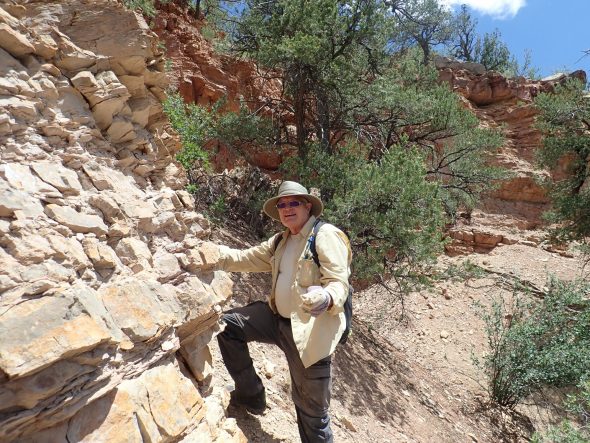
Wanderlusting the Madera fossil beds
320 million years ago, New Mexico was a shallow tropical sea studded with large islands. These were the peaks of the Ancestral Rocky Mountains, formed when Africa collided with North America and compressed the Earth’s crust in the New Mexico area. Blocks of crust were forced upwards by the compression to form mountain ranges in areas surprisingly close to where the ranges of the modern Rocky Mountains are located.
One of these ranges is the Sierra Nacimiento, the long north-south mountain range that lies on the west side of the Jemez Mountains. The core of this range is Precambrian rocks, the youngest of which are 1.4 billion years old. Surrounding the core, and covering some portions of it, are much younger beds, of which the oldest are Carboniferous limestone beds of the Arroyo Penasco, Osha Canyon, and Madera Formations. Geologists who have closely studied these beds have discovered that they were laid down in shallow water surrounding an island thrown up as part of the Ancestral Rocky Mountains. This island so closely resembled the present Sierra Nacimiento that there is even an ancient thrust fault running along its western edge that is nearly on top of the modern thrust fault along which the Sierra Nacimiento was thrown up. This tells geologists that faulted blocks of crust can persist over hundreds of millions of years, the faults lying latent until some tectonic event reactivates them.
The ancestral Sierra Nacimiento eventually was brought down, by a combination of erosion and subsidence, to be buried by Permian red beds of the Abo and Cutler Formations. Remnants of these are still found atop the core of the range, along with much younger Abiquiu Formation beds 25 million years old. This tells us the crust block lay quiescent for almost 300 million years before being thrust up again not more than 25 million years ago. The absence of beds between about 250 million years and 25 million years in age says that the block of crust resisted subsidence even as the areas around it subsided and accumulated sediments of those ages. Then came a brief period of subsidence in Abiquiu time, followed by rapid uplift that may still be continuing today.
The Pennsylvanian limestone beds of the Madera Formation are among the best marine fossil beds in North America. Those in San Diego Canyon are particularly rich in brachiopods, which are shellfish resembling molluscs but from a very different lineage. There are also fossils of crinoids, relatives of modern starfish; bryozoans, coral-like animals more closely related to brachiopods; and a smattering of other species.
I had promised a friend, Marc Burnside, and his teenage son, Steve, that I would take them fossil hunting, and Gary Stradling was also keen on the expedition. I picked out six promising sites. We took Gary’s Jeep, since there might be some poorer roads along the way. Our first stop was north of the Rincon Fishing Site, at a road cut long recognized as good fossil hunting ground. Here were are close to the top of the Madera Formation, where the limestone is rich in clay and eventually grades into the Abo Formation.
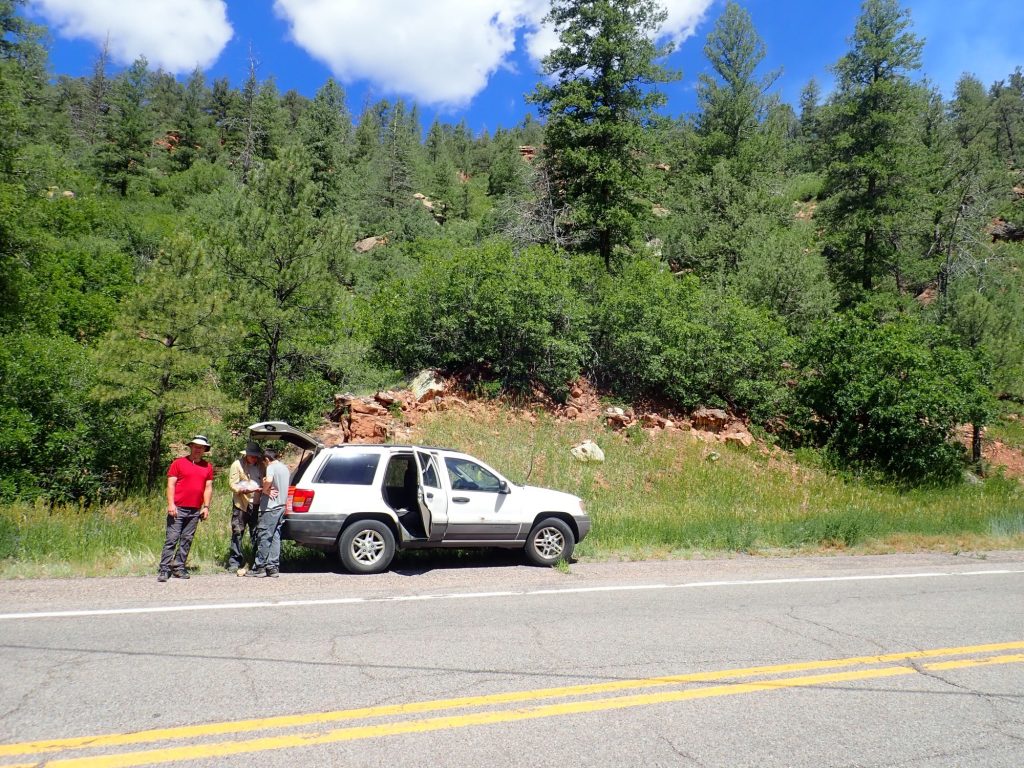
We climb up into the wooded area, close to the Madera-Abo contact, and after some minutes searching begin to find some fossils.
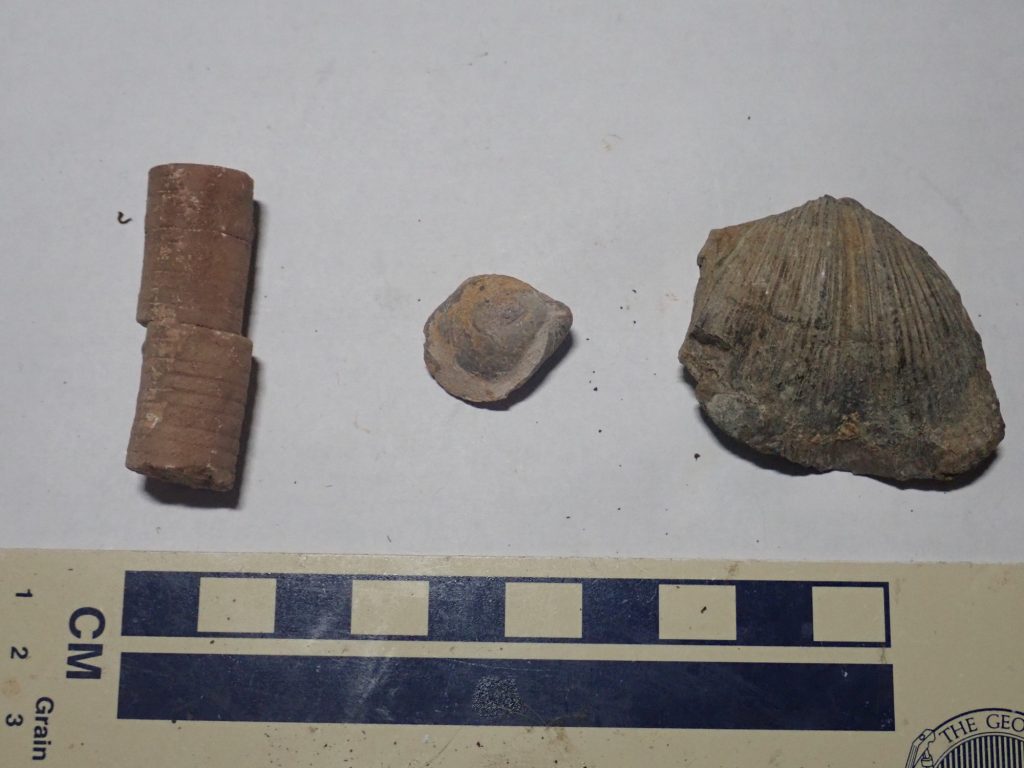
At left is a crinoid stem that partially separated in the middle. The stem is a stack of calcareous disks that fit together very much like a stack of poker chips, complete with radial grooves. This held up the body and feeding fronds of the animal, and was covered with living tissue before being fossilized. Here’s a modern crinoid.

The middle fossil is a small brachiopod. It looks a little like a clam, but molluscs and clams are quite distinct lineages, whose last common ancestor lived fully 610 million years ago. Clams are molluscs whereas brachiopods are lophophorans, animals having a lophophore as a feeding organ. This is a structure covered with tentacles which in turn are covered with cilia, all of which filter food out of seawater and convey it to the animal’s mouth. Clams have no lophophore, filtering seawater with gills instead. Another important difference is that the two shells of a clam (or any other bivalve mollusc) lie on the two sides of its body, whereas the two shells of a brachiopod lie on the top and bottom of its body. This means that bivalve molluscs tend to have shells that are reflections of each other, while there is no such symmetry in brachiopod shells. You can see in my photograph that the shell on top is smaller than the shell on bottom. The joint between the two shells of a brachiopod is particularly asymmetric and is the fastest way to tell a brachiopod from a mollusc.
At right is a fragment of a larger brachiopod.
Here’s a picture of a modern brachiopod.

The stalk is not something that is obvious in fossils, since it tends not to be preserved.
Both bryozoans and crinoids are extremely successful forms of life. Brachiopod fossils first appear in the early Cambrian and so have survived for almost 540 million years. Crinoids appeared somewhat later, in the Ordovician, but that’s still an impressive 460 million years. Primates have only been around for 55 million years or so and Homo sapiens for only about 350,000 years. As a species, we’re babies.
The pickings at this site are somewhat slim. This area is apparently well-known to the UNM Geology Department, and the students appear to have picked it over pretty thoroughly. We head south to the next fossil site, which is the general area northwest of Hummingbird Music Camp. It’s larger and so not likely as well picked over, but it’s also harder to find the precise spots for finding the most fossils.
This area is notable for its occasional sulfur smells from nearby hot springs, and today is no exception. We park next to beds that show some signs of hydrothermal activity — the rocks are whitened and the sulfur smell is noticeable. But I also find a small brachiopod almost at once, so I figure we’re on the right track. We head up the nearest arroyo to where there is a row of cliffs.
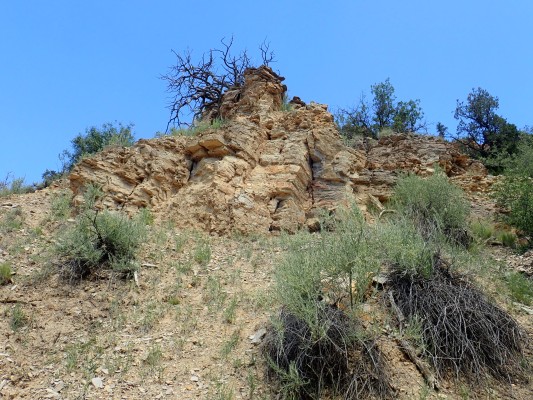
The beds here are argillaceous limestone, containing an unusual amount of clay minerals. This seems to be a good environment for preserving fine details of fossils.
We are collecting the occasional brachiopod fossil, though I didn’t keep any; I’ve got enough in my collection that I’m inclined to keep only the most spectacular finds today. But Steve, Marc’s teenage son, is having a great time finding what he can, and Marc and Gary are enjoying the hike.
It’s a fairly strenuous scramble up the arroyo, but eventually we come to a particularly thick sequence of fine shale beds.
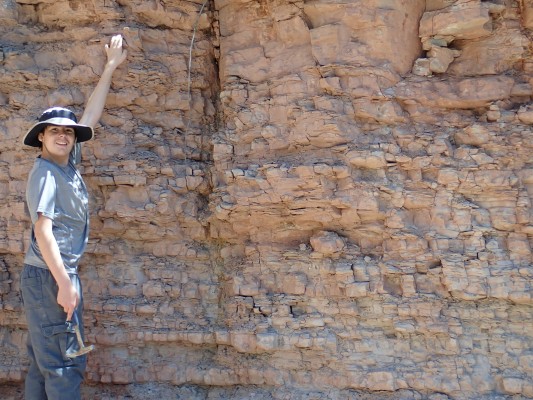
My initial impression is that these are almost devoid of fossils. I will later discover that this is not quite true; there are some impressive fossils in the lowermost layers.
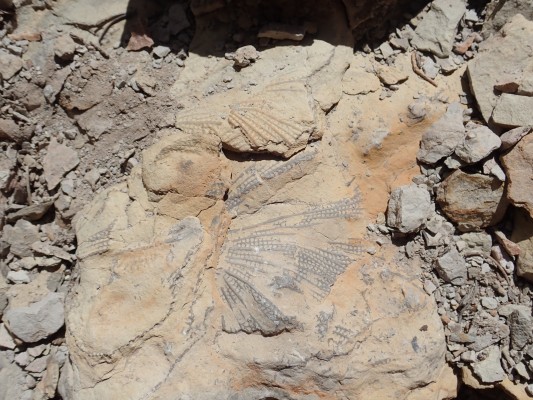
This is a fairly large fossilized colony of bryozoans. These are distant cousins of brachiopods, forming the other main branch of the lophophorans. Bryozoans are tiny compared with brachiopods and do not have a shell per se; instead, they occupy pockets in a calcareous “frond”. You can see the fronds and their pockets fossilized in the rock here. Superficially this resembles a colony of coral, but bryozoans are more closely related to us than they are to corals. (Way, way back on the Tree of Life, to be sure: Our most recent common ancestor with corals lived about 680 million years ago, while our most recent common ancestor with bryozoans lived about 650 million years ago.)
The first true bryozoans appeared around 480 million years ago, and they are another very successful family, still with us today:

The catch with such organisms is that their presence in a fossil bed doesn’t easily tell you much about its age, though they tend to be more common in Carboniferous beds and individual species can sometimes pin down the exact age — if you are a good enough paleontologist to identify individual species. I ain’t.
Gary coaxes me up to a high sequence of thin limestone beds that definitely contain fossils.
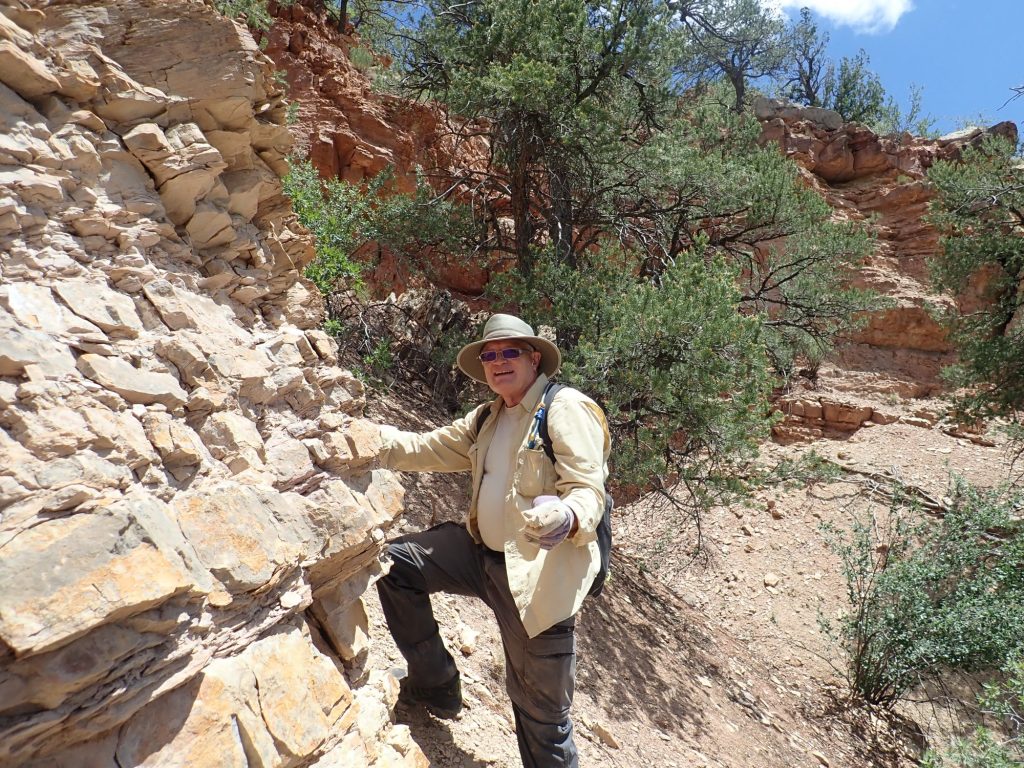
Gary is having a great time. Can you tell?
There are fusulinids in profusion in some of these beds. Beyond are redder beds indicating the transition to the river deltas of the Abo Formation, near the Pennsylvanian-Permian boundary.
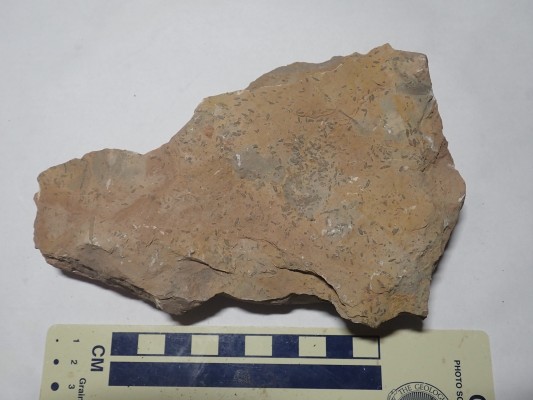
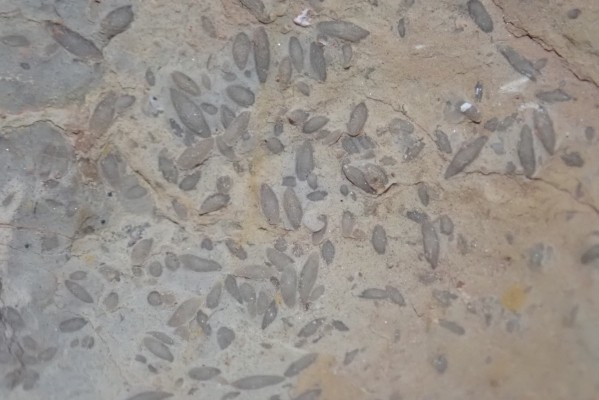
Fusulinids are among the larger single-celled organisms to have ever lived. Giant relatives of amoebas, they secreted characteristic tests or shells of calcite resembling grains of rice in size and shape. You can see numerous such tests covering the rock surface here. Unlike the fossils we’ve seen so far, fusilinids lived over a relatively narrow range of time, first appearing in the upper Mississippian, about 330 million years ago. They were completely wiped out by the “Great Dying”, the catastrophic mass extinction at the end of the Permian, 252 million years ago. So their presence immediately tells even an amateur paleontologist like myself that these beds are upper Paleozoic, between 330 and 252 million years old.
A good paleontologist can make a thin section of a fusilinid, which has an elaborate pattern of internal partitions that identify an exact species and make fusilinids good index fossils for determining the exact age of a bed.
Marc, Steve, and I start down, thinking Gary is right behind us. After a few minutes we realize we’ve left him behind. I shout out but get no response. Uh oh. Steve remains below to hunt weathered-out fossils in the drainages (at which he has considerable success) while Marc and I head up to be sure Gary is okay. It turns out he’s fine; there are some weird acoustic shadows in this rugged terrain, so he fades in and out as we climb back up while calling out to each other.
On the way up are beds that look a little like they might be algae mats. This would represent a time of very shallow, stagnant water.
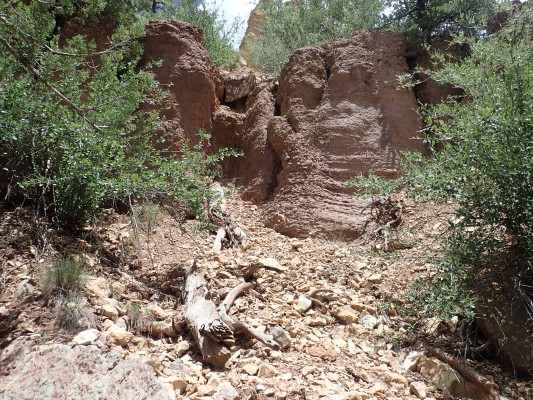
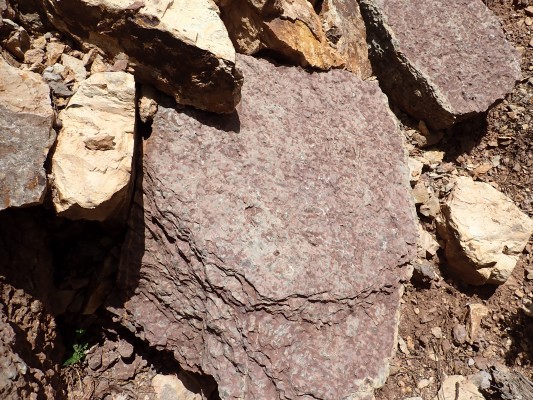
I don’t know for sure that these are actually fossil algae mats. They may be a fairly ordinary shale, marking part of the transition to river delta.
We find Gary further up. We explore a bit more, and then, on the way down, find some keepers. Here is something quite rare for the upper Madera Formation:
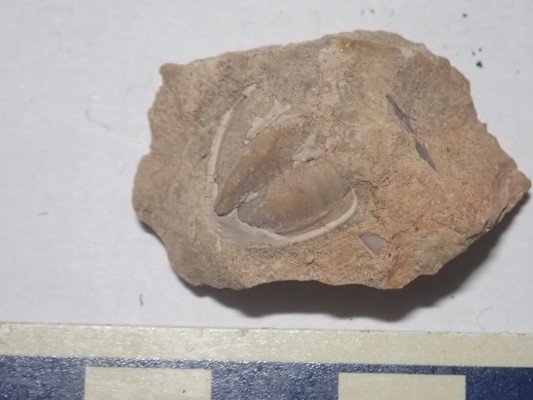
I’ve scrutinized this, and am reasonably confident it is a partial fossil of a trilobite, possibly Servillea. Trilobite fossils are known to be present in the Madera Formation, but they’re pretty scarce. Trilobites, distant relatives of insects and crustaceans, are among the earliest fossils found in the Cambrian and are very common until the middle Devonian, when all but a single order went extinct. The last of the trilobites were finally wiped out in the “Great Dying.”
I hoped to find some winged brachiopods, so-called for the long extensions of their hinge line. I have some luck:
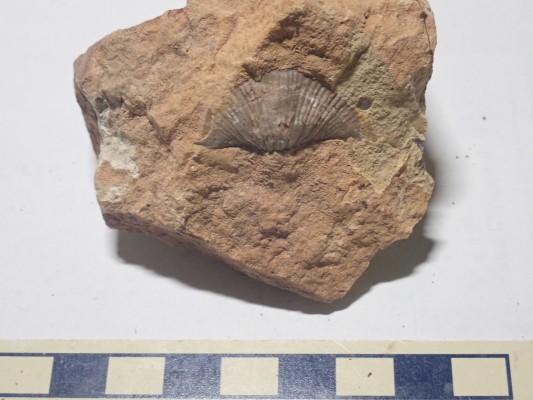
Possibly Mucrospirifer. I also try hammering out the bryozoan colony I showed earlier; alas, I cannot get it out intact. But, in the process, I spot what I take for a shellfish imprint.
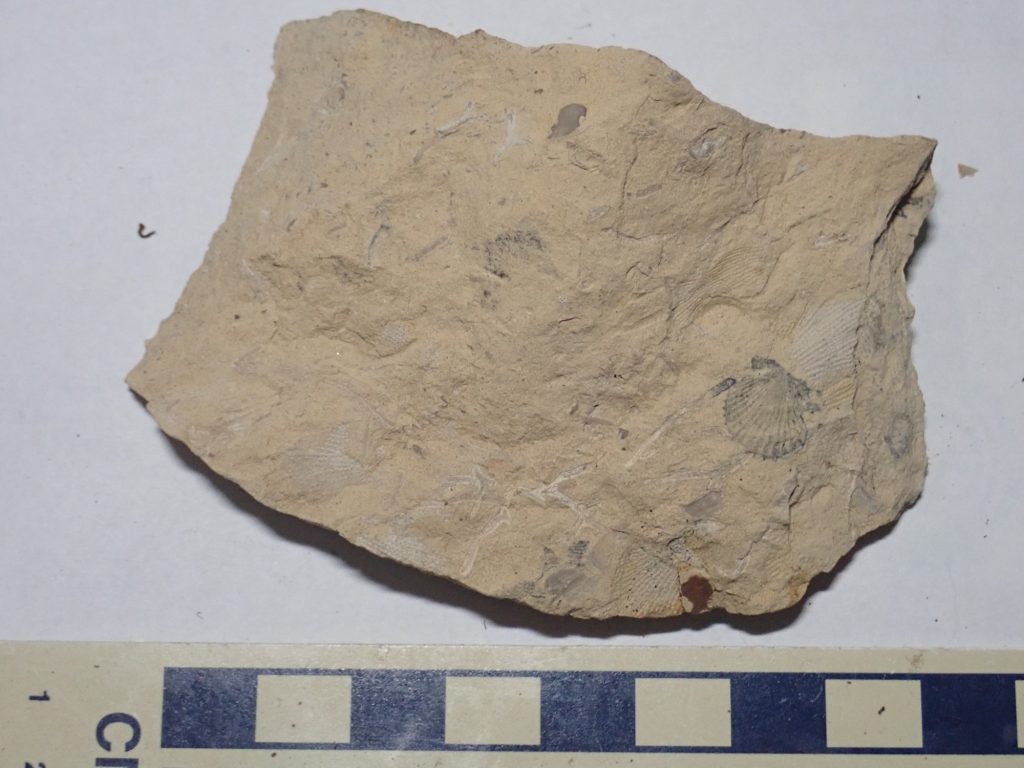
At right. I don’t think much of it at the time, except that I have never seen anything quite like it before and think it might be interesting.
We find Steve, who has had some success finding weathered out fossils close to the road. I conclude that I could have chosen a better arroyo to follow up to the beds,though of course I did not know that at the time. I’ve not explored this area that much.
It’s already past noon. I suggest that we skip sites 3 and 4, which are likely more of the same of what we saw here. For what it’s worth, site 4 is along the gravel road in the Rio Guadelupe valley, easily accessible but probably well picked over for that reason, and not different from what we’ve already seen. Site 3 is supposedly the Mother Load of brachiopod fossils — reports are there are spots where the entire ground is covered with a gravel of weathered out fossils, which is actually plausible — but, as you can see, you have to cross the unbridged Rio Guadelupe and hike a good distance up a mountain. Also, while I’ve visited site 3 and found fossils, I’ve not visited site 4 and would have to search for the best site.
Instead, we head north, to the Jarosa area, east of the San Pedro Mountains. Here we find few weathered out fossils, but many spectacular fossil slabs. There seem to be two fossil assemblages. The first is rich in crinoid stem segment.
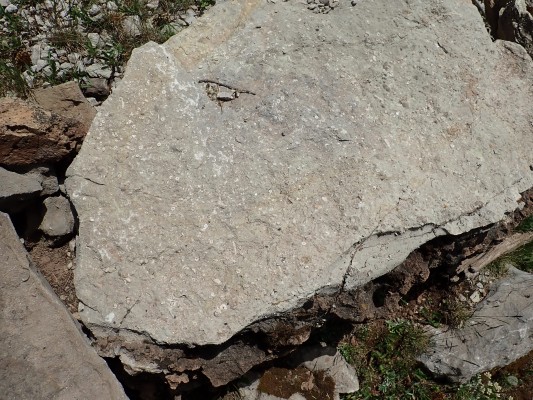
(You can click to enlarge, as with most images at this site.)
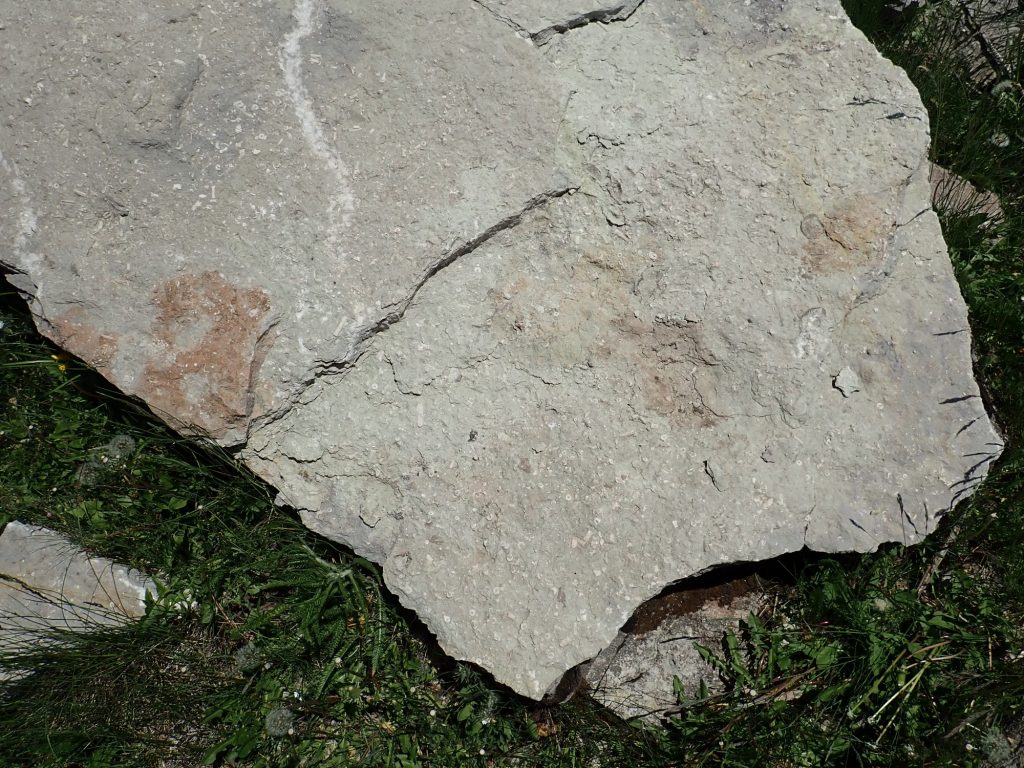
The second has long, thin fossils I took as stems of a smaller crinoid species, which seem less likely to break into small sections.
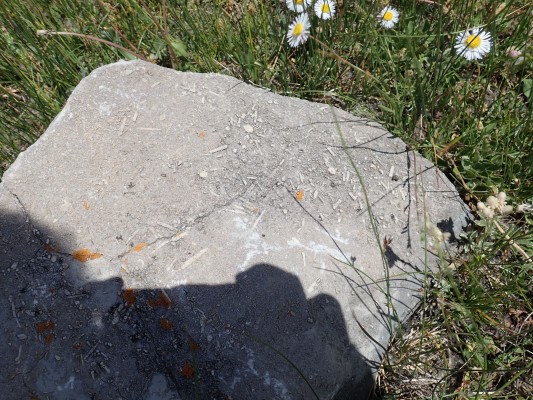
It was not until I got back home that I realized what was likely going on; more on that later.
There was also one slab with cobbles of granite embedded in it.
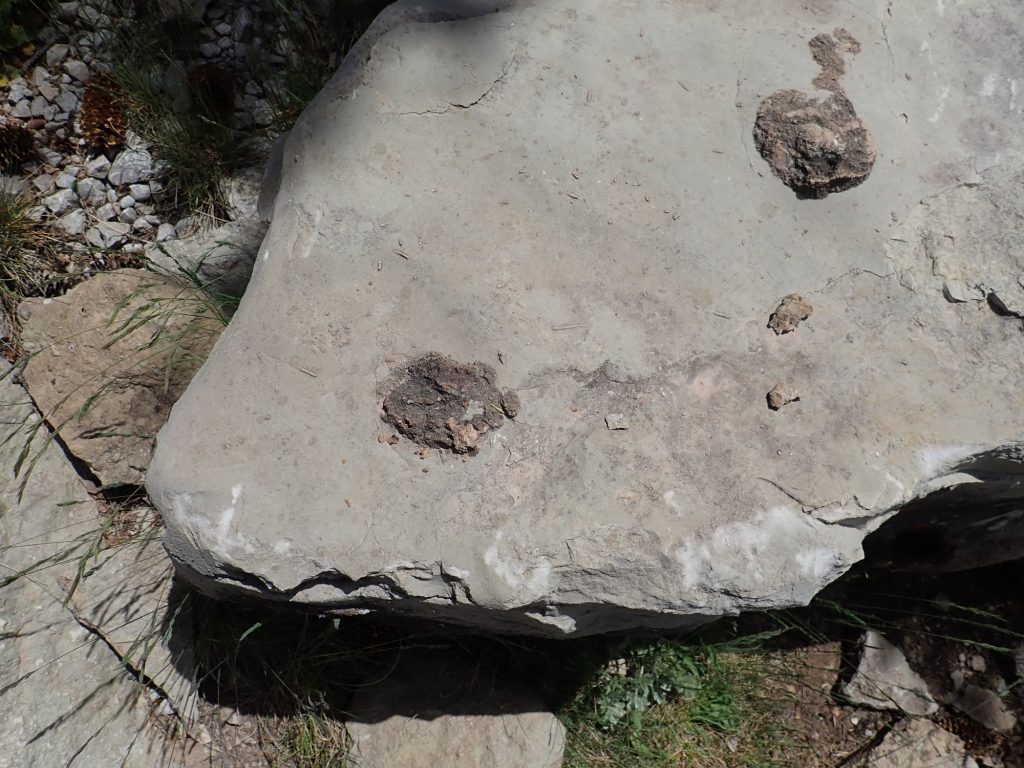
I first take these for nodules of chert, amorphous silica, which are not uncommon in limestone. However, Gary hammers one, and the fragments look like granite from the nearby Precambrian rocks of the Sierra Nacimiento. So these may be cobbles weathered off the ancestral Sierra Nacimiento into the Pennsylvanian sea.
Gary and Marc are sufficiently impressed with the fossil slabs that they each load a large slab into Gary’s Jeep to take home as yard rocks. I already have a small yard rock and decline the opportunity, but I’m thinking now I should have done it. Mine was what I could carry alone and it wasn’t as rich in fossils as the others.
We’re getting tired of all the fun, so I skip the final site, Site 6, which is probably a poorer version of what we’ve just looked at. We head home, stopping briefly at another outcrop that catches Gary’s eye. There are almost no fossils here, alas, except that Steve finds an oddly shaped rock that looks remarkably like a very large snail. Maybe. Steve also finds an old tin can that resembles a World War II rations can; he seems more excited by this than by the fossils. He’s gotten into military history lately, apparently.
Then home. We drop off Gary’s slab, then Marc and Steve and their slab. Back at Gary’s, he shows me his latest purchased acquisitions: an ammonite fossil and a crinoid slab. I find myself giving the ammonite fossil the hairy eyeball; enough tool marks to suggest a forgery. Scrutinizing it more closely, I find some genuine ammonite shell, and conclude that it’s a real fossil that got some fairly hamhanded touch up work before Gary purchased it. Medieval curiosity merchants sometimes carved snake’s heads on real ammonite fossils, so this is a long tradition.
The crinoid fossil is almost too good to be true; a slab with a nearly complete stem, body, and feeding tentacles.
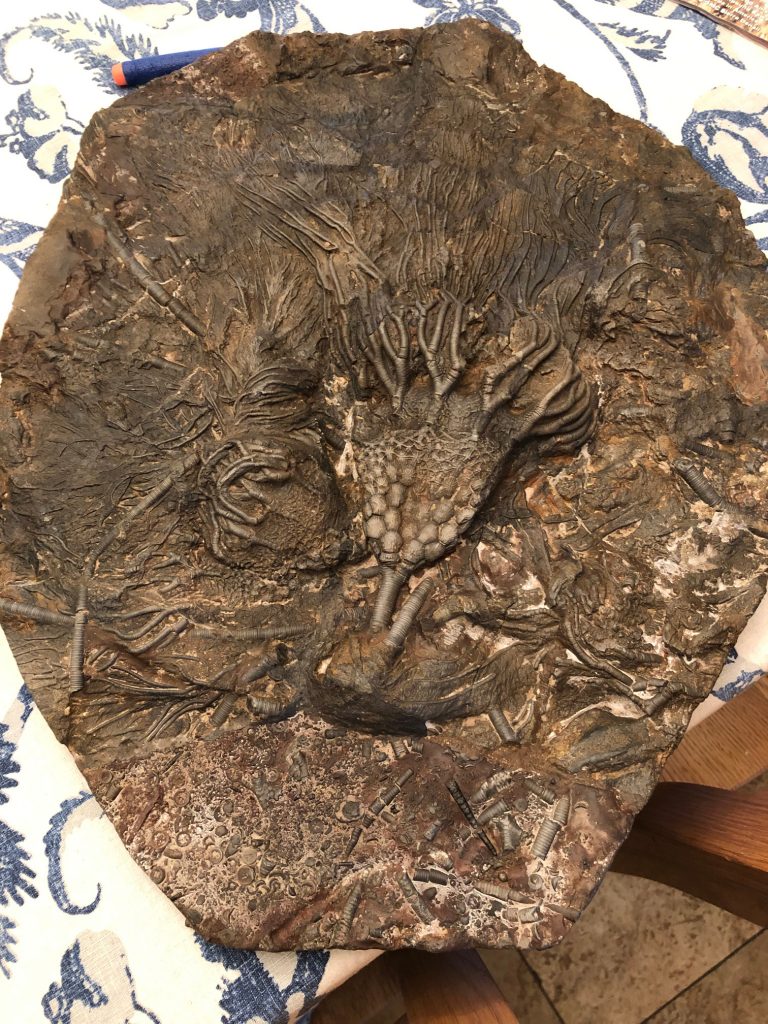
These are extraordinarily rare, and I’m not surprised Gary paid large dollars for it. He put a lot of work into polishing it up, and the fact that doing so exposed such a fine fossil is a mark of authenticity. I guessed that Gary paid several hundred dollars for it; the guess was apparently shy of the mark. A genuine museum piece.
But it told me something: The two crinoid assemblages we saw near Jarosa are not two species, but rather the small, straighter, less disarticulated pieces are feeding fronds. Looking again at those slabs, I see what look like body plates mixed in here and there. Cool.
And when I scrutinize my shellfish imprint, I start wondering if it’s really a shellfish.
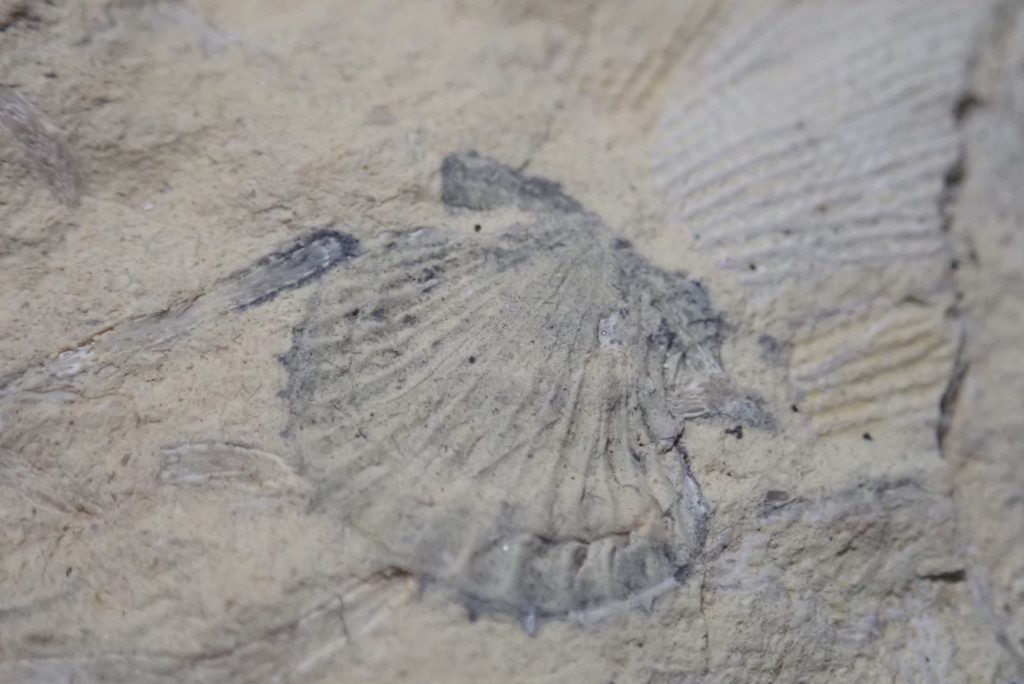
A calcite shell shouldn’t produce what looks like a carbon film fossil. I don’t know what this is. And I find that this rock is covered with tiny fossils, mostly bryozoans. You can see some frond bryozoans by the shellfish-whatever. In fact, they cover most of the surface.
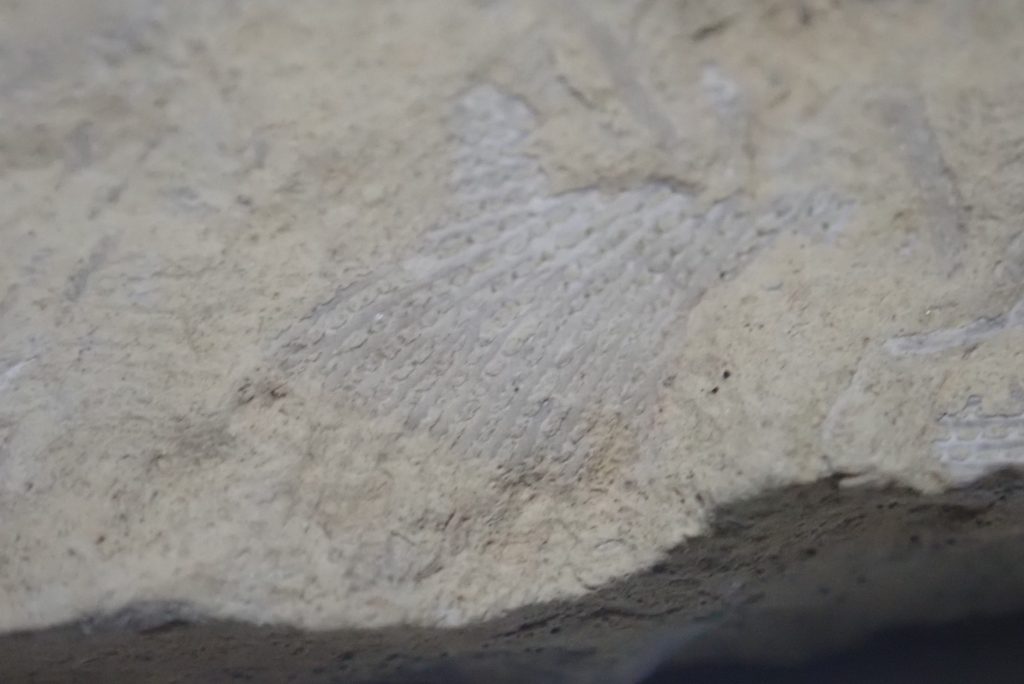
There are more on the other side of the rock.
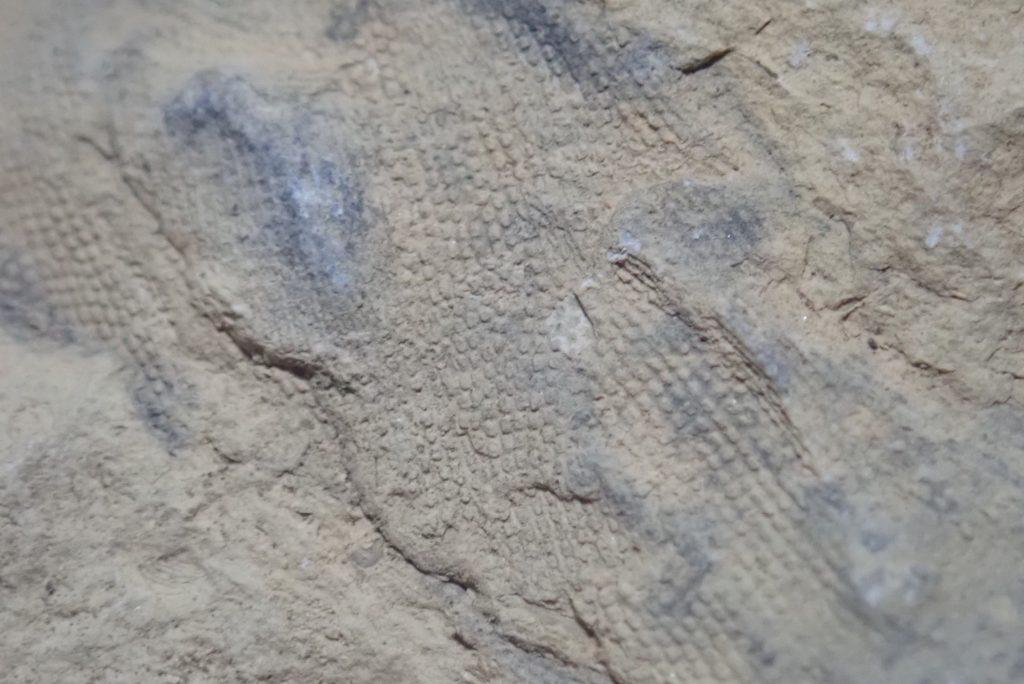
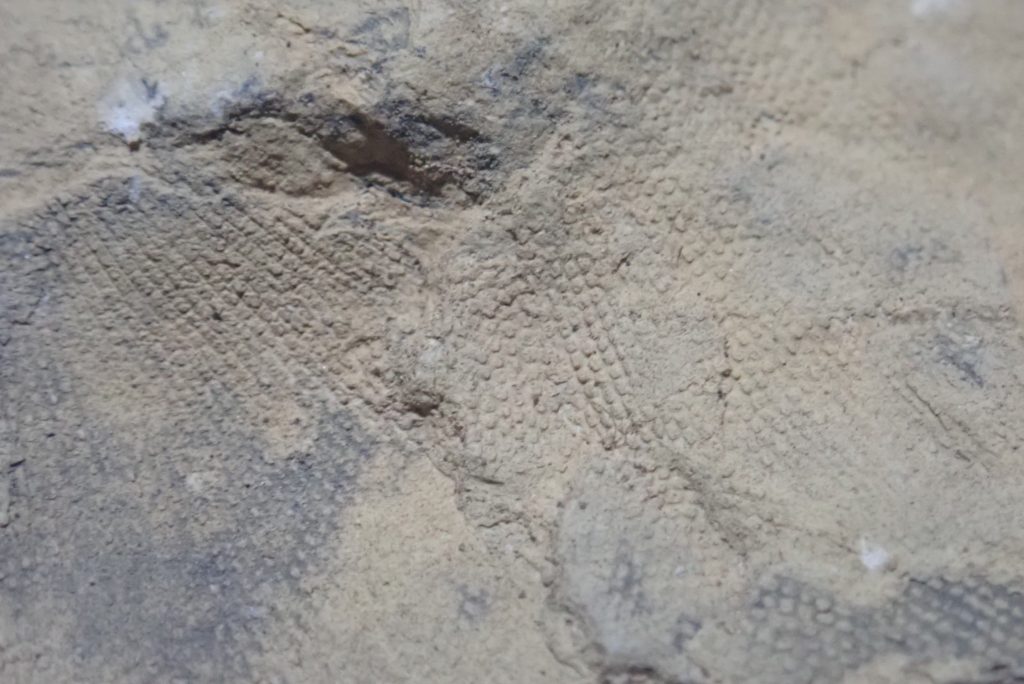
Also some branching bryozoans.
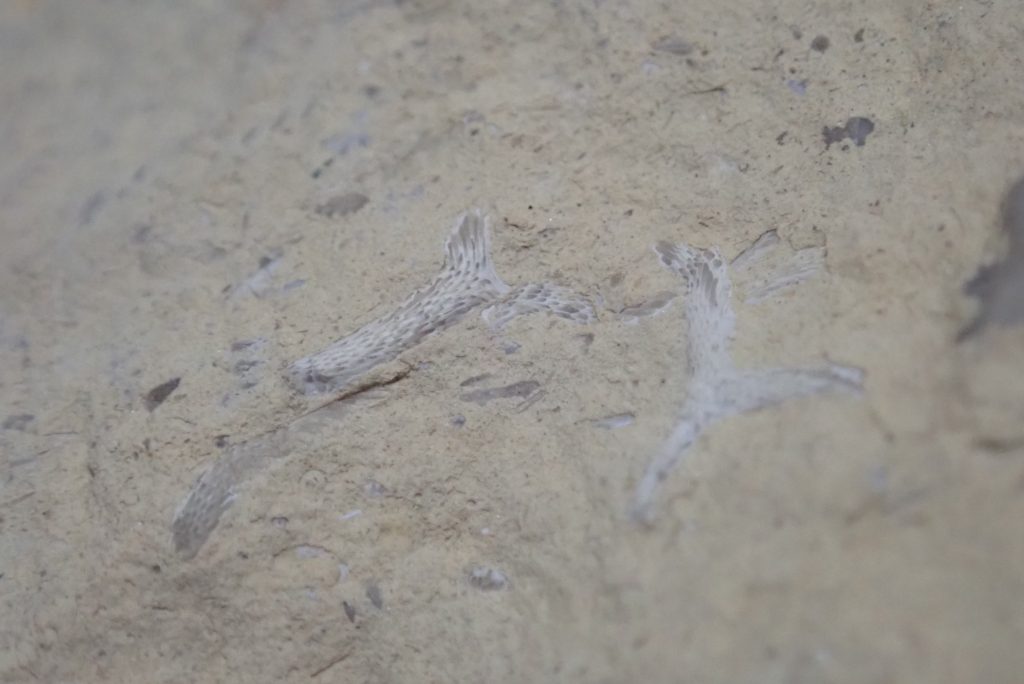
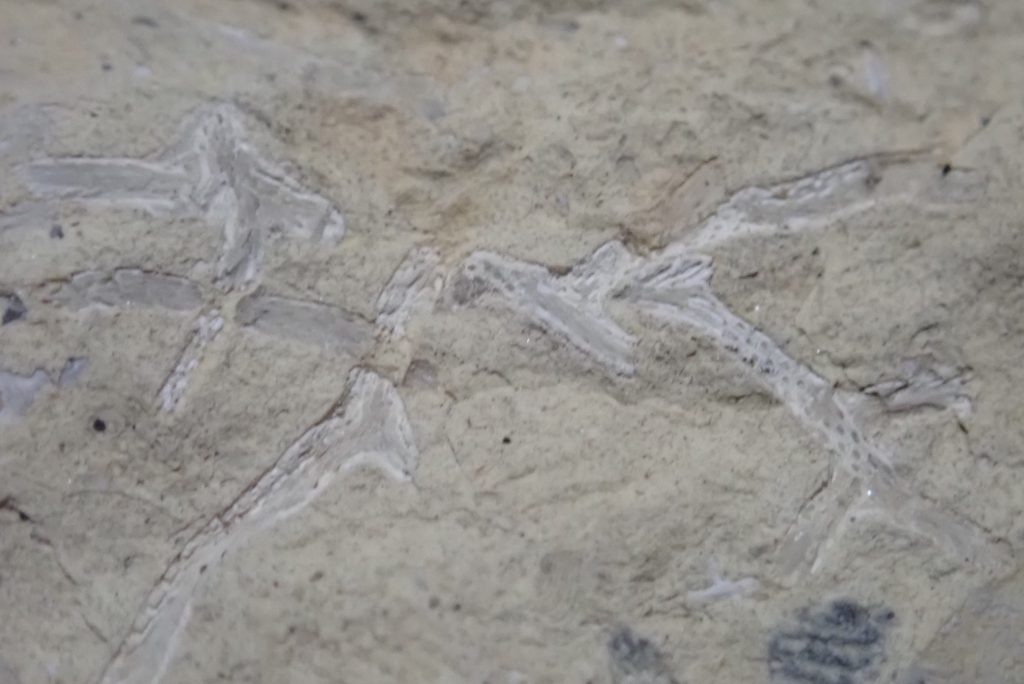
Apologies for picture quality. I’m still learning how to use the micro feature of the new Wandercamera.
Finally, there’s a big crinoid stem running through the middle of the specimen, visible on one edge in cross section. I could try polishing out the crinoid stem, but I’m afraid I’d destroy too many of the bryozoan fossils. Still, a far more fascinating specimen than I realized when I picked it up. It looks almost like a Konzentrat-Lagerstätten, the holy grail of fossil preservation.
I got a feeling I’m going to be spending more time at these beds.

Hello, I just moved to tularosa new Mexico a year ago and was curious if you could help me with this rock
Thank you for sharing your wonderful adventures in New Mexico. I’m new to Santa Fe and love this place. And it’s strange rocks.